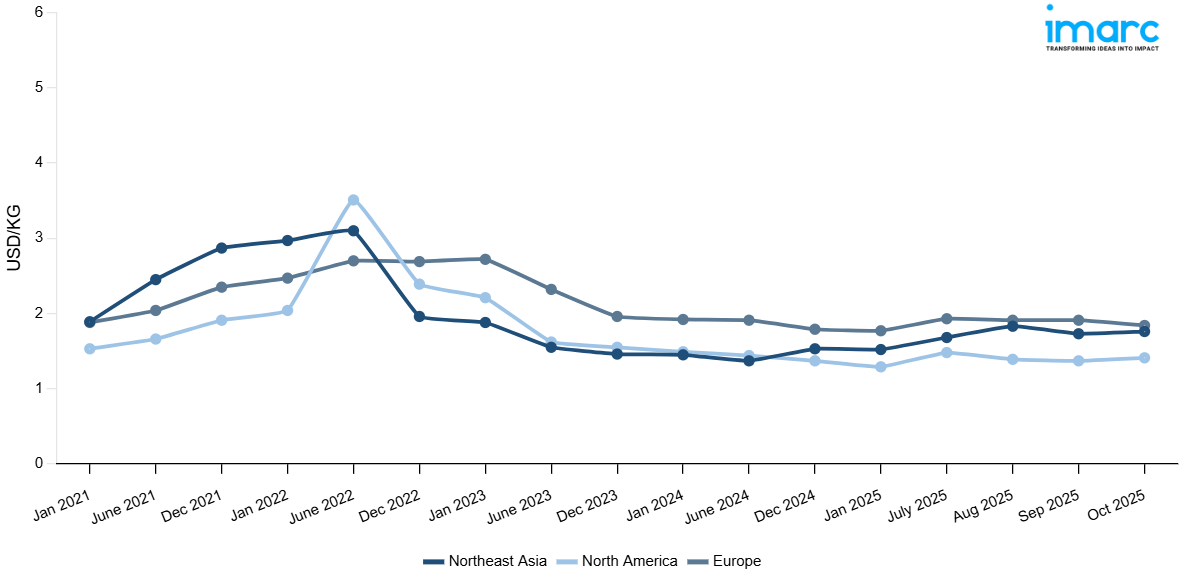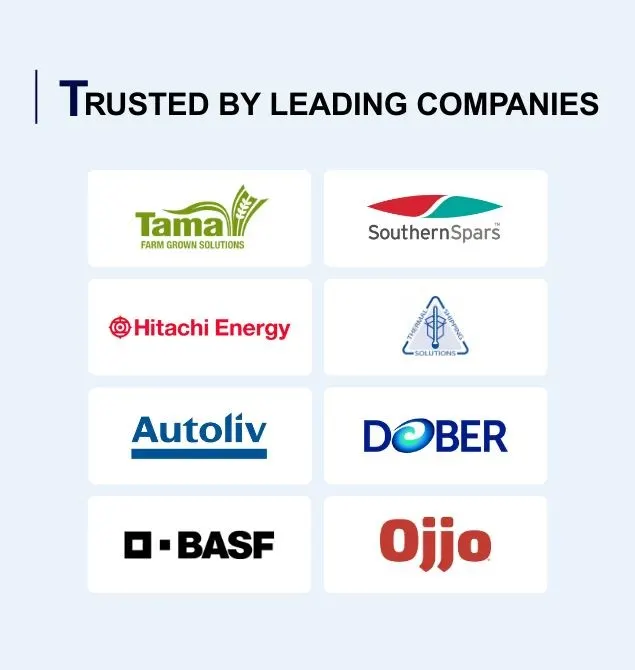
Epichlorohydrin Prices, Trend, Chart, Demand, Market Analysis, News, Historical and Forecast Data Report 2025 Edition
Epichlorohydrin Price Trend, Index and Forecast
Track real-time and historical epichlorohydrin prices across global regions. Updated monthly with market insights, drivers, and forecasts.
Epichlorohydrin Prices October 2025
| Region | Price (USD/KG) | Latest Movement |
|---|---|---|
| Northeast Asia | 1.76 | 1.7% ↑ Up |
| Europe | 1.84 | -3.9% ↓ Down |
| North America | 1.41 | 3.0% ↑ Up |
Epichlorohydrin Price Index (USD/KG):
The chart below highlights monthly epichlorohydrin prices across different regions.

Get Access to Monthly/Quaterly/Yearly Prices, Request Sample
Market Overview Q3 Ending September 2025
Northeast Asia: In Northeast Asia, epichlorohydrin prices declined as weak demand from the epoxy resins sector weighed on market fundamentals. Stable availability of feedstock propylene and glycerin ensured consistent production, contributing to oversupply conditions. The epichlorohydrin price index reflected subdued procurement activity from coatings and construction industries, with limited export demand further exacerbating downward pressure.
Europe: In Europe, epichlorohydrin prices remained stable, supported by balanced supply-demand conditions. Demand from epoxy resins and coatings applications held steady, while consistent feedstock availability allowed producers to manage operating rates effectively. The epichlorohydrin price index indicated equilibrium in procurement levels, with neither supply constraints nor significant demand fluctuations shifting regional pricing this quarter.
North America: In North America, epichlorohydrin prices edged down slightly as muted demand from the adhesives and automotive sectors restricted market momentum. Adequate feedstock supply maintained stable production, but sluggish downstream consumption kept the epichlorohydrin price index under mild bearish pressure. Limited export opportunities also prevented any significant recovery in regional prices.
Epichlorohydrin Price Trend, Market Analysis, and News
IMARC's latest publication, “Epichlorohydrin Prices, Trend, Chart, Demand, Market Analysis, News, Historical and Forecast Data Report 2025 Edition,” presents a detailed examination of the epichlorohydrin market, providing insights into both global and regional trends that are shaping prices. This report delves into the spot price of epichlorohydrin at major ports and analyzes the composition of prices, including FOB and CIF terms. It also presents detailed epichlorohydrin prices trend analysis by region, covering North America, Europe, Asia Pacific, Latin America, and Middle East and Africa. The factors affecting epichlorohydrin pricing, such as the dynamics of supply and demand, geopolitical influences, and sector-specific developments, are thoroughly explored. This comprehensive report helps stakeholders stay informed with the latest market news, regulatory updates, and technological progress, facilitating informed strategic decision-making and forecasting.
Epichlorohydrin Industry Analysis
The global epichlorohydrin industry size reached USD 3.18 Billion in 2024. By 2033, IMARC Group expects the market to reach USD 5.37 Billion, at a projected CAGR of 5.70% during 2025-2033. Growth is driven by the rising use of epichlorohydrin in epoxy resin production, which finds extensive applications in coatings, adhesives, electronics, and construction, along with increasing adoption of bio-based glycerin as a feedstock.
Latest developments in the Epichlorohydrin Industry:
- August 2025: Grasim Industries announced that it will commission an epichlorohydrin (ECH) plant at Vilayat by March 2026. This facility will boost its specialty polymers business amid rising demand across paints, coatings, and adhesives.
- June 2022: Meghmani Finechem Limited (MFL), a leading manufacturer of chlor-alkali and its value-added derivatives, announced the commissioning of the first Epichlorohydrin (ECH) Plant of 50,000 TPA capacity in India.
- December 2021: INOVYN launched its novel product featuring enhanced sustainability credentials under the brand name REODRINTM, becoming the first commercial producer of bio-attributed epichlorohydrin from renewable feedstock in the world.
Product Description
Epichlorohydrin (C₃H₅ClO) is a colorless, pungent liquid produced primarily through the chlorination of allyl chloride or via bio-based processes from glycerin. It is a reactive organochlorine compound and epoxide, valued as a key intermediate in chemical manufacturing. The majority of epichlorohydrin is consumed in the production of epoxy resins, which are widely used in coatings, adhesives, composites, and electronic components. Beyond this, it serves as a raw material for elastomers, water treatment chemicals, and synthetic glycerin. Epichlorohydrin’s reactivity and versatility make it critical across construction, automotive, aerospace, and industrial applications. Growing emphasis on sustainable and bio-based production routes is enhancing its role in the global chemical industry.
Report Coverage
| Key Attributes | Details |
|---|---|
| Product Name | Epichlorohydrin |
| Report Features | Exploration of Historical Trends and Market Outlook, Industry Demand, Industry Supply, Gap Analysis, Challenges, Epichlorohydrin Price Analysis, and Segment-Wise Assessment. |
| Currency/Units | US$ (Data can also be provided in local currency) or Metric Tons |
| Region/Countries Covered | The current coverage includes analysis at the global and regional levels only. Based on your requirements, we can also customize the report and provide specific information for the following countries: Asia Pacific: China, India, Indonesia, Pakistan, Bangladesh, Japan, Philippines, Vietnam, Thailand, South Korea, Malaysia, Nepal, Taiwan, Sri Lanka, Hongkong, Singapore, Australia, and New Zealand* Europe: Germany, France, United Kingdom, Italy, Spain, Russia, Turkey, Netherlands, Poland, Sweden, Belgium, Austria, Ireland, Switzerland, Norway, Denmark, Romania, Finland, Czech Republic, Portugal and Greece* North America: United States and Canada Latin America: Brazil, Mexico, Argentina, Columbia, Chile, Ecuador, and Peru* Middle East & Africa: Saudi Arabia, UAE, Israel, Iran, South Africa, Nigeria, Oman, Kuwait, Qatar, Iraq, Egypt, Algeria, and Morocco* *The list of countries presented is not exhaustive. Information on additional countries can be provided if required by the client. |
| Information Covered for Key Suppliers |
|
| Customization Scope | The report can be customized as per the requirements of the customer |
| Report Price and Purchase Option |
Plan A: Monthly Updates - Annual Subscription
Plan B: Quarterly Updates - Annual Subscription
Plan C: Biannually Updates - Annual Subscription
|
| Post-Sale Analyst Support | 360-degree analyst support after report delivery |
| Delivery Format | PDF and Excel through email (We can also provide the editable version of the report in PPT/Word format on special request) |
Key Benefits for Stakeholders:
- IMARC’s report presents a detailed analysis of epichlorohydrin pricing, covering global and regional trends, spot prices at key ports, and a breakdown of FOB and CIF prices.
- The study examines factors affecting epichlorohydrin price trend, including input costs, supply-demand shifts, and geopolitical impacts, offering insights for informed decision-making.
- The competitive landscape review equips stakeholders with crucial insights into the latest market news, regulatory changes, and technological advancements, ensuring a well-rounded, strategic overview for forecasting and planning.
- IMARC offers various subscription options, including monthly, quarterly, and biannual updates, allowing clients to stay informed with the latest market trends, ongoing developments, and comprehensive market insights. The epichlorohydrin price charts ensure our clients remain at the forefront of the industry.
Key Questions Answered in This Report
The epichlorohydrin prices in October 2025 were 1.76 USD/Kg in Northeast Asia, 1.84 USD/Kg in Europe, and 1.41 USD/Kg in North America.
The epichlorohydrin pricing data is updated on a monthly basis.
We provide the pricing data primarily in the form of an Excel sheet and a PDF.
Yes, our report includes a forecast for epichlorohydrin prices.
The regions covered include North America, Europe, Asia Pacific, Middle East, and Latin America. Countries can be customized based on the request (additional charges may be applicable).
Yes, we provide both FOB and CIF prices in our report.
Need more help?
- Speak to our experienced analysts for insights on the current market scenarios.
- Include additional segments and countries to customize the report as per your requirement.
- Gain an unparalleled competitive advantage in your domain by understanding how to utilize the report and positively impacting your operations and revenue.
- For further assistance, please connect with our analysts.
Why Choose Us
IMARC offers trustworthy, data-centric insights into commodity pricing and evolving market trends, enabling businesses to make well-informed decisions in areas such as procurement, strategic planning, and investments. With in-depth knowledge spanning more than 1000 commodities and a vast global presence in over 150 countries, we provide tailored, actionable intelligence designed to meet the specific needs of diverse industries and markets.
1000
+Commodities
150
+Countries Covered
3000
+Clients
20
+Industry
Robust Methodologies & Extensive Resources
IMARC delivers precise commodity pricing insights using proven methodologies and a wealth of data to support strategic decision-making.
Subscription-Based Databases
Our extensive databases provide detailed commodity pricing, import-export trade statistics, and shipment-level tracking for comprehensive market analysis.
Primary Research-Driven Insights
Through direct supplier surveys and expert interviews, we gather real-time market data to enhance pricing accuracy and trend forecasting.
Extensive Secondary Research
We analyze industry reports, trade publications, and market studies to offer tailored intelligence and actionable commodity market insights.
Trusted by 3000+ industry leaders worldwide to drive data-backed decisions. From global manufacturers to government agencies, our clients rely on us for accurate pricing, deep market intelligence, and forward-looking insights.
 Request Customization
Request Customization
 Inquire Before Buying
Inquire Before Buying
 Speak to an Analyst
Speak to an Analyst Request Brochure
Request Brochure




.webp)




.webp)












